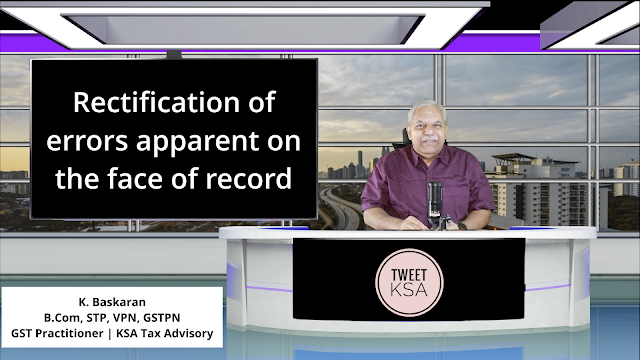Rectification of errors apparent on the face of record
Section 161
Section 161 of the CGST Act, 2017 states the rectification of mistakes or errors that are recognized from the records.
It mentions that the authority responsible for issuing decisions, orders, summons, notices, or certificates may rectify any mistake that is found in the records in such documents.
These rectifications are done by the below-mentioned relevant authority:
• Suo moto by such authority.
• Upon notice by the affected person
• Upon notices of such authority by GST officials (both at the Central and State levels).
The term “mistake evident from records” remains undefined under the GST Act, indicating an unmistakable error. In this context, Section 154 of the Income Tax Act of 1961, furnishes detailed provisions regarding the concept. The term “mistake,” from a legal perspective, includes the following scenarios:
• Misreading a clear provision is an error.
• Applying an inapplicable provision.
• Ignoring a mandatory provision.
• Application of an incorrect provision of the Act.
• Disregard of decisions by the jurisdictional High Court.
The word ‘record’ can be meant as a comprising of the whole situation, including entire proceedings such as documents and materials provided by the concerned parties and officially taken on record by the authorities. When the order was issued which is the subject matter of the rectification process, these records were available.
Both taxable individuals and officers designated in accordance with the GST law have the authority to ask for the commencement of rectification proceedings. A taxable individual must apply for rectification within three months from the date when the respective order, decision, notice, or certificate was issued.
A rectification order is required to be passed within the period of six months from the date of issuance of the respective order, decision, notice, certificate, or any other documents, in accordance with the Section itself. However, in the case where the rectification effect pertains only to rectifying clerical or arithmetic mistakes caused by unintentional slips or omissions, this six-month time limit is not applicable. In such cases, the authority may act by issuing a notice and rectifying the error on their own initiative or based on a report from any officer appointed under the act, within a span of two years from the issuance of the original document.
Useful GST Rule 142(7)
In cases, where rectification of the directive has been issued under Section 161 or in cases, where an order uploaded on the portal has been taken back, then the proper officer must upload the abstract of the rectification order or the withdrawal order electronically in Form GST DRC-08.
As per the regulations, the Proper Officer must upload an abstract of the rectification order issued under Section 151 electronically in Form GST DRC-08. This same form can also be utilized for the withdrawal of the directive. This form includes information on the original order and rectification order and a summary of the original claim and demand post-rectification.





No comments:
Post a Comment